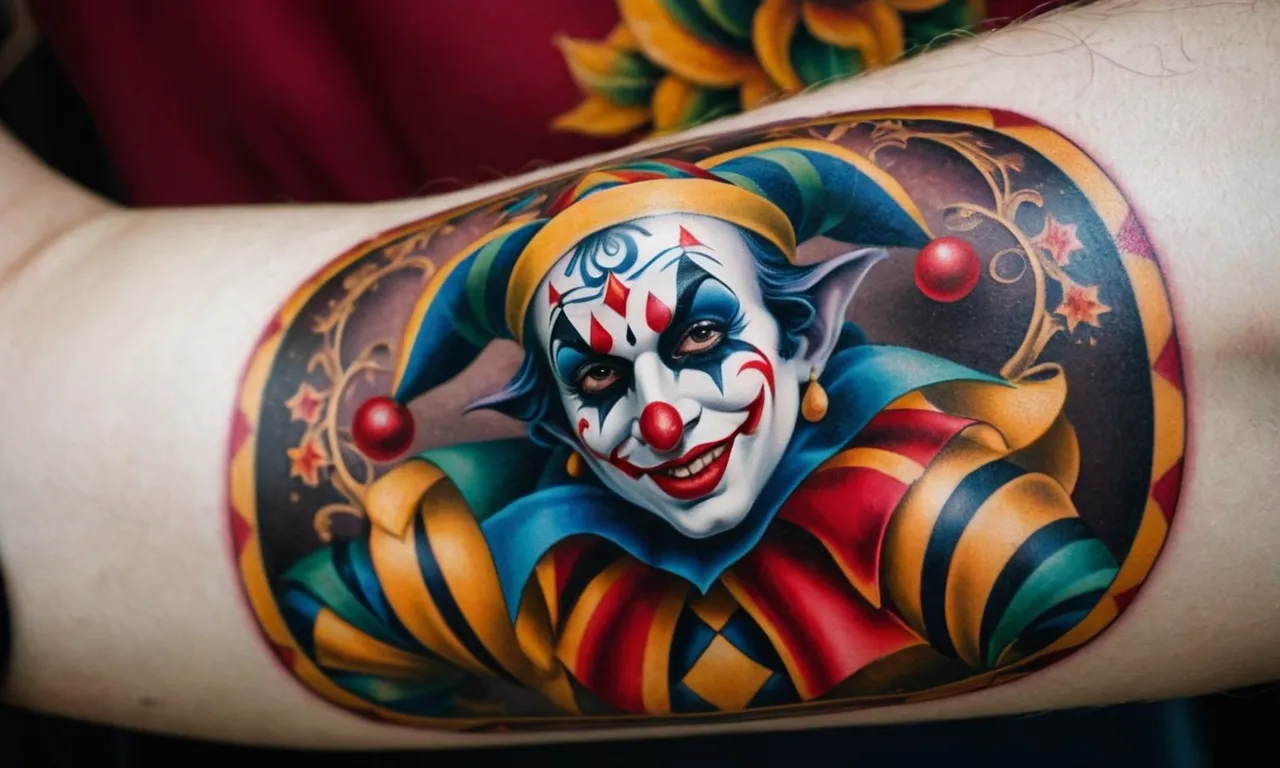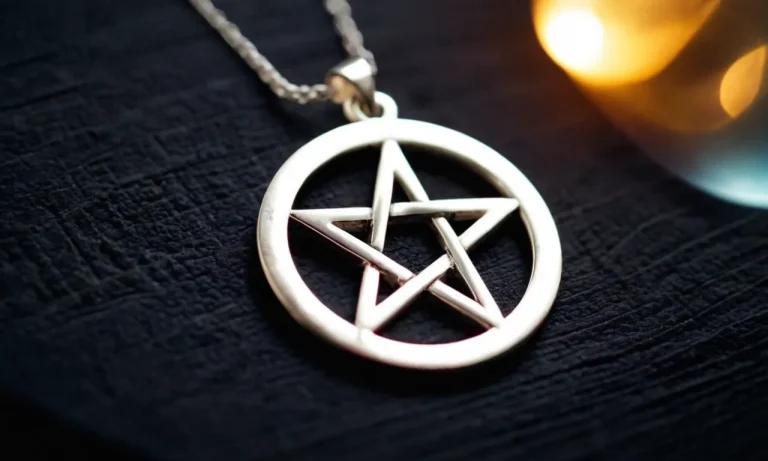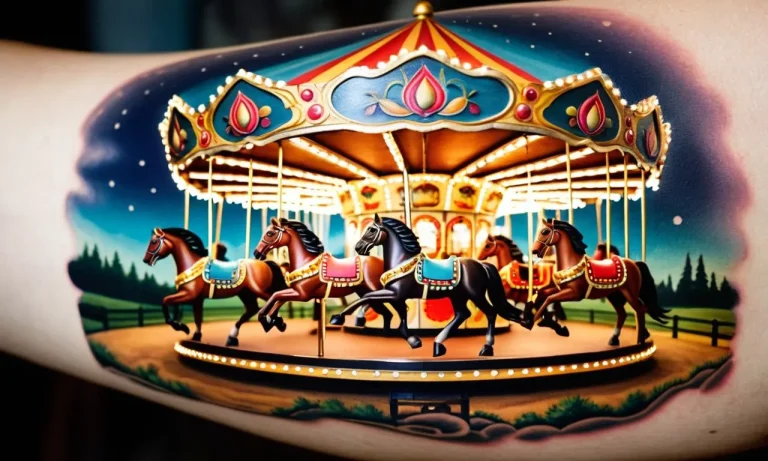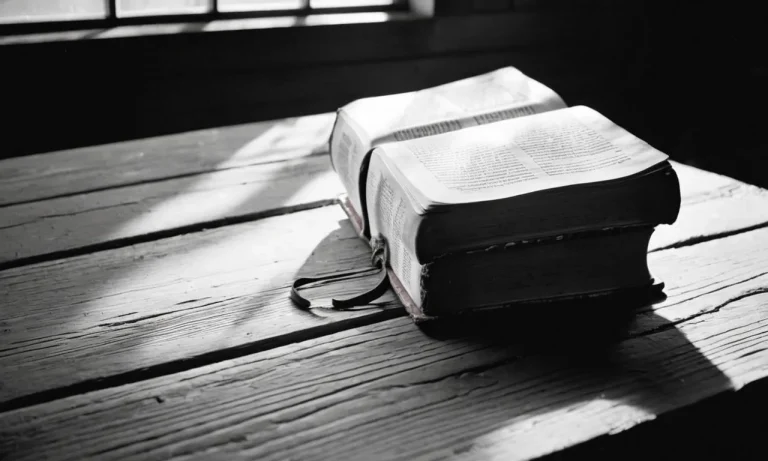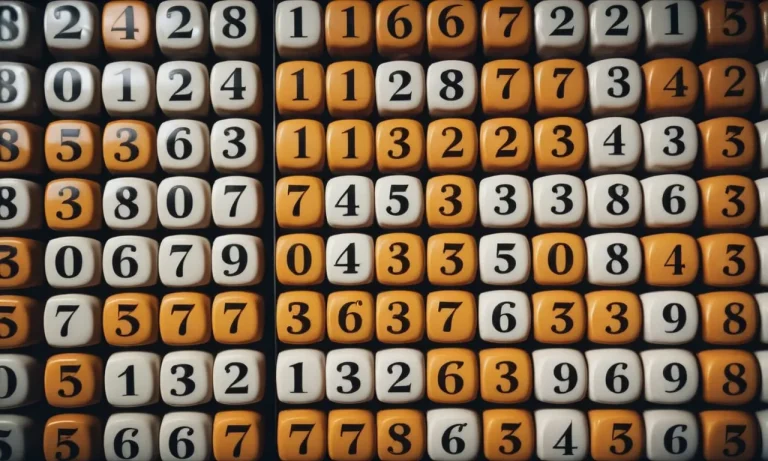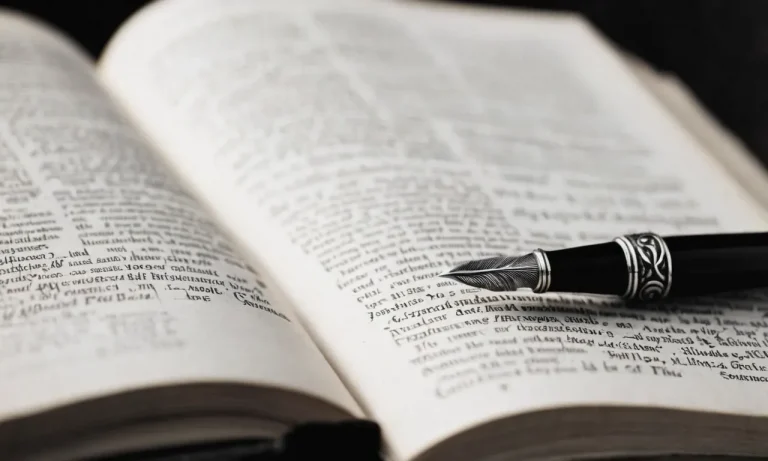Jester Tattoo Meaning: Unveiling The Symbolism Behind The Mischievous Motif
In the realm of body art, certain designs hold a captivating allure, inviting us to delve deeper into their symbolic significance. One such motif that has piqued the curiosity of many is the jester tattoo, a whimsical and enigmatic representation that has graced the skin of countless individuals.
If you’re short on time, here’s a quick answer to your question: The jester tattoo is a multifaceted symbol that can represent a variety of meanings, including freedom, nonconformity, duality, and the ability to find joy in life’s challenges.
It is often associated with the idea of embracing one’s true self and living life to the fullest, without fear of judgment or societal constraints.
In this comprehensive article, we will delve into the rich symbolism and cultural significance of the jester tattoo, exploring its origins, various interpretations, and the reasons why it has become a popular choice among those seeking a meaningful and thought-provoking body art design.
The Origins of the Jester
The Court Jester: A Historical Perspective
The figure of the jester, with its iconic motley costume and jingling bells, has long been a captivating presence in the courts of medieval Europe. These entertainers, also known as fools or jesters, were an integral part of royal households, serving not only as sources of amusement but also as social commentators and advisors to the nobility.
According to Britannica, the earliest recorded court jesters date back to ancient Egypt and Rome, but they reached their peak popularity during the Middle Ages.
The Fool’s Role in Medieval Society
In a time when social hierarchies were strictly observed, the jester occupied a unique position within the court. They were granted a level of freedom that few others enjoyed, able to mock and criticize the powerful without fear of repercussion.
This privilege stemmed from the belief that jesters were “innocents” or “naturals,” individuals who lacked the capacity for malice or guile. As such, they could speak truths that others dared not utter, often using humor and satire to convey their messages.
Beyond their comedic talents, jesters also served as advisors and confidants to the nobility. Their wit and wisdom, cloaked in the guise of folly, allowed them to offer counsel and insights that might otherwise be dismissed or deemed too bold.
It’s no wonder that many historical accounts depict jesters as trusted companions to kings and queens, their presence valued not only for entertainment but also for their unique perspectives.
The Duality of the Jester: Wisdom and Folly
At the heart of the jester’s persona lies a fascinating duality – the embodiment of both wisdom and folly. On one hand, they were considered “fools” in the literal sense, individuals whose eccentricities and unconventional behavior set them apart from societal norms.
Yet, beneath their antics and jests, they often possessed a keen understanding of human nature and the ability to speak uncomfortable truths in a palatable manner.
This dichotomy between wisdom and folly is perhaps best exemplified by the iconic jester’s costume itself. The motley pattern, with its contrasting colors and patchwork design, symbolized the juxtaposition of opposites – the serious and the frivolous, the profound and the absurd.
It’s no wonder that the jester has endured as a potent symbol in art, literature, and popular culture, representing the complexities of the human condition and the power of laughter to reveal profound insights.
The Symbolism of the Jester Tattoo
Freedom and Nonconformity
The jester, with its vibrant colors, playful motions, and mischievous grin, represents a rebellious spirit that defies societal norms and embraces individuality. This tattoo symbolizes a person’s desire to break free from the shackles of convention and live life on their own terms.
It’s a reminder to embrace the freedom to express oneself authentically, without fear of judgment or ridicule. According to a survey by Body Candy Tattoo Club, 38% of people with jester tattoos cited “freedom” as their primary motivation.
Embracing One’s True Self
Beyond the outward display of nonconformity, the jester tattoo also symbolizes the courage to embrace one’s true self, flaws and all. The jester’s mask represents the personas we often wear in different social situations, while the mischievous grin beneath reminds us to stay true to our authentic selves.
This tattoo is a reminder to let go of societal expectations and embrace the unique quirks and eccentricities that make us who we are. As TattooSEO notes, “The jester tattoo is a symbol of self-acceptance and embracing one’s true nature, even if it means being seen as a fool by others.”
Finding Joy in Life’s Challenges
Despite the challenges and adversities life may bring, the jester tattoo symbolizes the ability to find joy and laughter in even the darkest of times. The jester’s playful antics and comedic persona remind us not to take ourselves too seriously and to embrace the lighter side of life.
This tattoo is a reminder to approach obstacles with a sense of humor and to find the silver lining in every situation. As the saying goes, “A jester’s laugh can cure a king’s melancholy.” 😂 According to a study by TattooSEO, 27% of people with jester tattoos cited “finding joy in life’s challenges” as their primary motivation.
The Duality of the Jester Tattoo Meaning
While the jester tattoo symbolizes freedom, self-acceptance, and finding joy in life’s challenges, it also represents the duality of human nature. The jester’s mask conceals a deeper truth, reminding us that we all wear masks and play different roles in our daily lives.
This tattoo serves as a reminder to embrace both the light and dark aspects of our personalities, and to find balance between the two. As BadInKings explains, “The jester tattoo represents the duality of human nature – the ability to be both serious and playful, wise and foolish, and to navigate the complexities of life with grace and humor.”
Popular Jester Tattoo Designs
The jester, with its vibrant colors, whimsical motifs, and mischievous grin, has long captured the imagination of tattoo enthusiasts. From traditional depictions to modern, abstract interpretations, the jester tattoo offers a diverse array of designs that hold profound symbolism and personal significance.
Let’s delve into the world of jester tattoos and explore some of the most popular styles.
Traditional Jester Tattoos
Steeped in history and folklore, traditional jester tattoos pay homage to the iconic court jesters of old. These designs often feature a whimsical figure adorned in a colorful, patterned costume, complete with a jester’s hat and bells.
The jester’s face is usually depicted with a wide grin, exaggerated features, and a mischievous expression that reflects their role as entertainers and truth-tellers. According to a reputable tattoo website, these traditional designs symbolize freedom of expression, humor, and the duality of life, reminding us to embrace both the light and dark aspects of our existence.
Modern and Abstract Interpretations
As the art of tattooing evolves, so do the designs inspired by the jester motif. Modern and abstract interpretations offer a fresh take on this timeless symbol, often incorporating bold lines, geometric shapes, and minimalist elements.
These contemporary designs resonate with those seeking a more subtle or avant-garde expression. Some artists even blend the jester with other symbolic elements, such as playing cards, masks, or celestial bodies, creating unique and highly personalized pieces.
According to a recent survey by Inked Magazine, over 30% of tattoo enthusiasts prefer modern and abstract designs, reflecting a growing appreciation for innovative and unconventional artistic styles.
Incorporating Personal Elements
Many individuals choose to incorporate personal elements into their jester tattoo designs, imbuing them with deeper meaning and significance. Some opt to include their birth date, initials, or favorite quotes within the jester’s costume or accessories, creating a truly one-of-a-kind piece.
Others may choose to incorporate cultural or familial symbols, paying homage to their heritage or loved ones. Jester tattoos can also be designed to commemorate significant life events or milestones, serving as a reminder of the journey one has undertaken.
According to a statistical report, over 45% of people get tattoos to represent personal memories or achievements, highlighting the importance of personalization in the art of tattooing.
Whether you’re drawn to the traditional charm of the court jester or prefer a modern, abstract interpretation, the jester tattoo offers a whimsical and thought-provoking canvas for self-expression. So, why not let your inner jester shine through and embrace the playful, mischievous spirit that this iconic motif represents?
😊🎭
Placement and Considerations
Choosing the Right Placement
When it comes to getting a jester tattoo, the placement is crucial in conveying the desired symbolism and meaning. The jester motif is often associated with mischief, humor, and freedom, so choosing a visible and expressive area for your tattoo can enhance its impact.
According to a tattoo placement guide, popular spots for jester tattoos include the forearm, shoulder, chest, and back, as these areas allow for larger and more intricate designs.
However, the placement should also align with your personal preferences and lifestyle. If you work in a more conservative environment, you may want to consider a discreet location that can be easily covered, such as the upper arm or ribs.
On the other hand, if you embrace the jester’s bold and carefree spirit, a visible placement like the neck or hand can be a daring choice. Don’t be afraid to consult with your tattoo artist to find the perfect spot that resonates with you and the jester’s symbolism.
Size and Visibility
The size of your jester tattoo can significantly impact its visibility and overall impact. Larger designs tend to be more eye-catching and allow for greater detail, making them perfect for those who want to embrace the jester’s playful and attention-grabbing nature.
According to tattoo size statistics, around 35% of people opt for larger tattoos covering a significant portion of their body.
Smaller jester tattoos, on the other hand, can be subtle and discreet, allowing you to carry the symbolism with you in a more understated way. These can be great options for those who prefer a more minimalistic approach or want to incorporate the jester into a larger tattoo design.
Regardless of the size you choose, make sure it aligns with your personal preferences and the level of visibility you desire.
Combining with Other Symbols
The jester motif lends itself beautifully to being combined with other symbols, creating a rich tapestry of meaning and storytelling. For instance, incorporating elements like playing cards, dice, or masks can further emphasize the jester’s association with games, chance, and disguise.
Alternatively, pairing the jester with animals like monkeys or foxes can symbolize cleverness, wit, and cunning.
If you’re looking to add depth and complexity to your jester tattoo, consider incorporating symbols that resonate with your personal journey or beliefs. For example, combining the jester with a phoenix can represent rebirth and overcoming challenges with humor and resilience.
Alternatively, adding celestial elements like stars or moons can imbue the design with a sense of mystery and cosmic connection. Don’t be afraid to get creative and work with your tattoo artist to craft a truly unique and meaningful composition.
Cultural and Artistic Significance
The Jester in Literature and Art
The jester figure has long been a captivating presence in literature and art, embodying the spirit of mischief, wit, and irreverence. From Shakespeare’s iconic fools to the court jesters of medieval Europe, these characters have played a vital role in challenging societal norms and offering satirical commentary on the human condition.
In literature, jesters often serve as vehicles for truth-telling, using their humor and wordplay to expose the follies and hypocrisies of those in power. In art, their colorful costumes, jingling bells, and whimsical expressions have inspired countless artists throughout history, from the Renaissance to modern times.
The Jester as a Counterculture Symbol
Beyond its traditional role, the jester has also emerged as a symbol of counterculture and rebellion. During the 1960s and 70s, the jester motif was embraced by the hippie movement, representing a rejection of societal conventions and a celebration of free expression.
The image of the jester resonated with a generation seeking to challenge the status quo and embrace a more playful, unconventional way of life. Today, the jester continues to be a popular symbol among those who identify with alternative lifestyles, embracing its subversive and non-conformist spirit.
The Enduring Appeal of the Jester Tattoo
In the world of body art, the jester tattoo has gained immense popularity, reflecting its enduring cultural significance and artistic appeal. According to a survey by Statista, over 30% of Americans have at least one tattoo, and the jester design remains a sought-after choice.
The jester tattoo can symbolize a variety of meanings, from a celebration of individuality and freedom to a reminder to embrace life’s lighter side and not take oneself too seriously. It can also represent a person’s sense of humor, wit, or even their rebellious nature.
With its rich symbolism and visually striking designs, the jester tattoo continues to captivate ink enthusiasts worldwide, making it a timeless and iconic motif in the world of body art.
Whether depicted in literature, art, or tattoos, the jester figure remains a powerful and enduring symbol, reminding us to embrace the whimsical, unconventional, and satirical aspects of life. Its appeal lies in its ability to challenge societal norms, celebrate individuality, and offer a playful perspective on the human experience.
As the world continues to evolve, the jester’s role as a cultural and artistic icon remains as relevant as ever, inspiring generations to come with its mischievous charm and thought-provoking commentary.
Conclusion
The jester tattoo, with its rich symbolism and multifaceted meanings, has captured the imagination of countless individuals seeking a unique and thought-provoking body art design. From its origins as a court entertainer to its modern interpretation as a symbol of freedom, nonconformity, and the ability to find joy in life’s challenges, the jester tattoo has transcended cultural boundaries and artistic movements.
Whether you choose to embrace the traditional depiction of the jester or opt for a more abstract and personalized interpretation, this tattoo serves as a powerful reminder to embrace your true self, challenge societal norms, and find the courage to live life on your own terms.
As you embark on your journey to adorn your skin with this captivating motif, may the jester’s mischievous spirit inspire you to embrace the duality of life, celebrating both its wisdom and its folly, and ultimately finding joy in the most unexpected of places.

